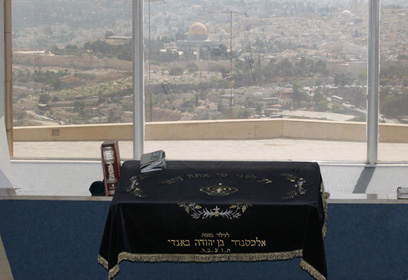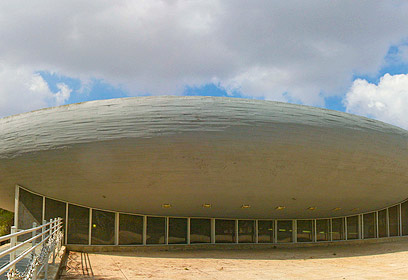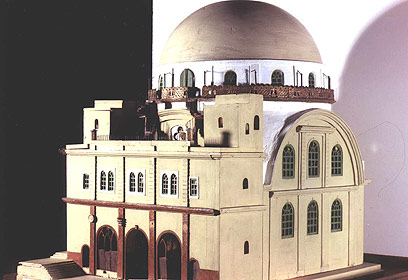Israel's most beautiful synagogues – part 2
Hurva Synagogue Aug 2014)
Ahead of Yom Kippur, Ynet asks 10 leading architects to select the 10 most beautiful and special temples in Jewish state, each with its own character and beauty. Here is the second article in this festive project
Sigalit Fishbein
|
After presenting the project's first five synagogues on Sunday, we are now proud to present the last five temples, as well as a special one being rebuilt, each accompanied by a picture, a description of the structure written by the selecting architect, and an ID including details about the nature of the prayers at each site.
6. Ohel Aharon Synagogue, Haifa
_g.jpg)
Photo: Orly Zeiler
About the structure
The Ohel Aharon Synagogue was designed by Professor Aharon Kashtan. It was built in a modernistic style in a period influenced by Swiss architect Le Corbusier, who was active during the 1930s. Technological innovations throughout this period took the field of architecture one step forward and allowed a release from traditional architecture.The synagogue is not big and sheds a feeling of intimacy between the person and the community of worshippers, and between the person himself and his prayer. It is located in the middle of the Technion campus, but hides between the trees. When walking, one must "discover" it, as it does not "thrust itself" into one's face.
The structure itself is simple and powerful. It has presence. The synagogue is built on pillars, rather than as one layer on top of another, and gives a feeling of a light and floating building. From a religious point of view, it seems to distinguish between Shabbat and weekdays.
The entrance is through a staircase providing a feeling of movement and approaching the sky. The building has circumferential windows through which light infiltrates and disconnects the roof from the structure, pointing again to the difference between man and sky. It directs the worshipper upwards.
- Selected by architect Tagit Klimor of Knafo Klimor Architects, whose works include Caesarea's Megillat Or Synagogue and who won the first prize in an international competition for residential buildings in China.
ID
Prayer times: The Yom Kippur morning prayer will begin at 7 am and the additional prayer will end at around 1 pm. The afternoon prayer will be held at 3 pm. A biblical discourse will be held after the "Kol Nidrei" prayer on Yom Kippur Eve and before the closing prayer. On Shabbat and weekdays, the prayer begins at 8 or 8:15 am.Prayer leader: On Yom Kippur the prayer is led by a professional cantor befitting the Technion spirit. Last year it was a physics doctorate graduate.
Version: The Sephardic version is used on Yom Kippur, while on regular days the cantor dictates the version.
Cost: None, but donations are welcome.
Number of worshippers: On weekdays there are approximately 200 worshippers, and sometimes even more. On Shabbat the number can range between 50 and 350, depending on whether it's an organized Shabbat (by the campus) or not. Last year there were 150 worshippers on Yom Kippur, and this year hopes are for a higher number of visitors.
Women's gallery: Located on the same level as the men's gallery, behind a screen.
Accessible to disabled people: No, "but no one has ever been left out because of a disability. The worshippers help people get in."
7. The Great Synagogue, Mazkeret Batya
_g.jpg)
Photo: Avi Moalem
About the structure
Mazkeret Batya's Great Synagogue on 1 Eliyahu Boulevard, designed by architect Pinhas Nit, is one of the most beautiful temples in Israel. It was built almost 100 years ago and is located in a dramatic place – the entrance to the central Israeli town.
The building has a beautiful entrance with a large arch welcoming its visitors. It is an interesting building with beauty marking the end of the 19th century. It has an atmosphere of the past and a lot of simplicity.
The place is reminiscent of synagogues in Europe, with towers on the sides – almost as if it was brought in from Poland, but with a local flavor. Its compactness resembles the spirit of the rural houses of the baron's colony.
- Selected by architect Israel Gudovich, Tel Aviv's former town planner, whose works include the Chabad Center in Moscow and the Hazeva Field School.
ID
Prayer times: The Yom Kippur morning prayer begins at 7 am and ends at around 12 pm. The "Kol Nidrei" prayer is held about one hour before sunset. The evening prayer begins at 8:15 pm on Shabbat, and at 6 pm on weekdays.Prayer leader: There are no cantors from the outside. The synagogue members lead the prayer.
Version: Ashkenazi, for more than 100 years.
Cost: For a couple, NIS 300 (about $86) per seat, NIS 60 ($17) for an additional person.
Number of worshippers: On Yom Kippur the synagogue is packed and "you can't even stick in a needle." There are 150 seats for men and about 110 for women.
Women's gallery: Located on the ground floor and on a gallery floor. The lower one was built 15 years ago.
Accessible to disabled people: Yes, although it's a bit more complicated for women.
8. Hecht Synagogue, Jerusalem

Photo: Gil Yohanan
About the structure
The synagogue was designed by architect Ram Karmi and is located at the Hebrew University's Faculty of Humanities on Mount Scopus. It's a small building, integrated into the faculty and located at the end of several corridors.
It faces Jerusalem's Temple Mount, providing an amazing view, particularly when seen in the framework of the studies.
The building itself is made of Jerusalem stone and white plaster on the inside. It is all very minimalistic. A bright, white light conveys the feeling of holiness. The synagogue's greatness is in its smallness. It conveys a feeling of a temple, a place of learning. Real architecture.
- Selected by architect Yaakov Sa'ar, who won the 2007 Israeli architecture prize. His works include the Jewish Museum in Berlin and the Silver Building of Biomedical Engineering at Haifa's Technion.
ID
Prayer times: The afternoon prayer is held between 3 pm and 4 pm. The evening prayer is held between the lectures. There is no morning prayer or Yom Kippur prayer in this synagogue as the campus is closed on Shabbat and holidays.Prayer leader: The synagogue doesn’t have a regular cantor.
Version: Varies according to the prayer leader.
Cost: None.
Number of worshippers: Throughout the semester there are several quorums, and a quorum will sometimes even include 80 worshippers. During vacations there may only be 30 worshippers attending the prayer.
Women's gallery: Located on the gallery floor.
Accessible to disabled people: Yes.
9. Central Synagogue, Nazareth Illit

Photo: Hagai Aharon
About the structure
The building, located on 3 Tabor Street, was designed by Nahum Zolotov and built in the 1950s. it is an amazing and amusing synagogue because it looks like a flying saucer on top of a hill, almost as if it is carved into the mountain. Like an unidentified flying object landing elegantly.
The entrance gives the feeling of entering a cave. The walls are made of crude stone, topped with a plate of concrete. It has rough materialism – bare concrete, which can be touched. It is a sensual synagogue.
The building characterizes the sabra construction, compared to the Jewish construction in the Diaspora. Jewish construction is like a chameleon – wherever the Jews were they adapted themselves to the atmosphere and culture , assimilating into the environment.
Synagogues abroad have nothing unique, no language. The sabra constriction, on the other hand, reflects a local language. It is direct, authentic, and sincere. It is exposed, not flamboyant and not decorative.
The architecture expresses the sabra – the foundation is bare so we can understand how the structure was built. There is a sense of drama in light and shade games and a drama on the plasticity. The raw stones, the non-plastered walls and the raw material at the synagogue are characteristic of the straightforwardness and bluntness of the strong and physical Israeli.
- Selected by Prof. Zvi Efrat, head of the Jack D. Weiler Department of Architecture at the Bezalel Academy of Art and Design and a partner in Efrat-Kowalsky Architects. His works include an extension of the Ghetto Fighters' Museum and the Israel Museum restoration project.
ID
Prayer times: On Yom Kippur the morning prayer begins at 8 am and ends at around 2 pm. On weekdays it begins at 6:45 am, and on Shabbat – at 8:30 am.
Prayer leader: Shaul Brichta, the synagogue's regular cantor for the past 15 years, will lead the prayer during the High Holidays. Throughout the year the cantors change.
Version: Sephardic. During events the celebrators decide on the adaptation, and oriental versions may also be included.
Cost: A seat costs NIS 125 ($36), but one doesn't have to pay. The veterans usually want to own a regular seat, so they buy it.
Number of worshippers: The synagogue is packed on Yom Kippur: Between 300 and 400 worshippers. The peak is at the "Yizkor" memorial prayer, which is sometimes attended by as much as 500 people, so there is not always room for everyone. On weekdays, some 20 worshippers arrive, on Saturdays it ranges between 30 and 40, and on special occasions (usually once every two or three weeks), 80 to 100 people attend the prayer.
Women's gallery: Located on the second floor.
Accessible to disabled people: Not at the moment.
10. The Great Synagogue, Tel Aviv
About the structure
From an architectural point of view, Tel Aviv's Great Synagogue on 110 Allenby Street is the most important temple in Israel, as it contains the history of Israeli architecture.In 1914, Israel's first architects' competition determined the synagogue's designer. The winner was Richard Michel, who designed the building, but left during the war and never returned.
The work was continued by Alexander Brewald, but the building was first completed by Yehuda Megidovich. In the 1930s an arcade was added by Ze'ev Rechter, and the building was renovated in 1961 by Ariel Hanani.
Today the synagogue is an important structure built in an international style: Starting with a romantic style, followed by the arcade representing the 1930s, and concluding with the 1960s innovation.
- Selected by architect Dr. Ami Ran, editor of the Architecture of Israel quarterly. His works include Beit Rishonim in Ness Ziona and the American school at the Ovda base.
ID
Prayer times: The Yom Kippur morning prayer will begin at 8 am (as on weekdays) and will end at around 1:30 pm. There will then be a 90-120 minute break, followed by the afternoon and closing prayers, which will end by the time the fast is over.Prayer leader: The synagogue's cantor on Yom Kippur is Yitzhak Nevo of Netanya, who has been leading the prayer for the third year in a row. A young cantor named Shlomo Piko will lead the prayer on Simchat Torah.
Version: Ashkenazi.
Cost: The synagogue invites everyone to pray. Entrance is free and there is no need to buy a place, but any donation is naturally welcome. The synagogue offices are open every day between 12-5 pm.
Number of worshippers: Some 100 worshippers are expected to arrive on Yom Kippur, and 20 to 30 attend on Shabbat. However, hundreds of worshippers arrived for the first evening of Selichot this year, requiring more seats at the passageway in addition to the 600 existing ones.
Women's gallery: Located on both sides of the synagogue with room for some 300 female worshippers.
Accessible to disabled people: Not yet, in process.
11. The Hurva Synagogue, Jerusalem

Photo courtesy of The Isaac Kaplan Old Yishuv Court Museum
About the structure
One of the synagogues mentioned repeatedly by architects interviewed for this project was the "Hurva" in Jerusalem on 89 Hayehudim Street.
The synagogue was built in the early 18th century but was destroyed 20 years later. It was rebuilt in the mid 19th century, but was destructed again during the War of Independence. The stone arch remained in place until a few years ago, as a silent memorial of the spiritual center located in the area for hundreds of years.
In 2002, the government eventually made a decision to rebuild the synagogue through the Jewish Quarter Development Company. Following comprehensive historic research, the reconstruction works began in 2005 and are expected to end in 2009.

_g.jpg)
How many holidays do the Arabs-Muslims celebrate due to historical events in the land of ancient Israel and Jerusalem.
ReplyDeleteThe Jewish people celebrate most of their holidays and fast days in memory of Jerusalem and Israel since 70 AD (that is over 2,000 years).
Pleading the Jewish goal and aspiration to return to Israel and rebuild the Temple in Jerusalem - where it was before it was destroyed and desecrated by the enemies of the Jews. Many of the Jewish prayers for thousands of years recite the love of Israel and the Jewish aspirations to return to their ancestral land and bring back its glory and holiness.
At Jewish weddings they break a glass in memory of Jerusalem and the aspiration to return and build the Jewish Temple in Jerusalem.
Every day at the end of the meal the Jews recite a blessing and thank G-d for providing sustenance and beseech G-d to return and rebuild the temple in Jerusalem.
Most Jewish prayers mention our pleading to return to Jerusalem and rebuild the Temple.